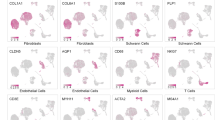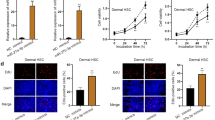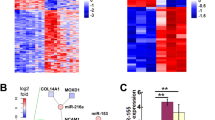Abstract
Neurofibromatosis type 1 (NF1) is caused by NF1 gene mutations. Patients with NF1 often have complications with tumors, such as neurofibroma. In order to investigate the pathogenesis of human neurofibroma, a systematic comparison of protein expression levels between Schwann cell-like sNF96.2 cells, which originated from malignant peripheral nerve sheath tumors (MPNST), and normal Schwann cells was performed using 4-D label-free proteomic analysis. In addition, the expression levels and localization of dysregulated proteins were confirmed using a Gene Expression Omnibus (GEO) transcriptomic dataset, Western blot analysis, and immunofluorescence labeling. The effects of SRY-box transcription factor 9 (SOX9) in the neurofibroma and surrounding microenvironment were evaluated in vivo using a tumor transplantation model. The present study observed that SOX9 and procollagen C-endopeptidase enhancer (PCOLCE) were significantly altered. NF1 mutation promoted the nuclear translocation and transcriptional activity of SOX9 in neurofibromas. SOX9 increased collagen VI secretions by enhancing the activation of PCOLCE in neurofibroma cells. These findings might provide new perspectives on the pathophysiological significance of SOX9 in neurofibromas and elucidate a novel molecular mechanism underlying neurofibromas.






Similar content being viewed by others
Data Availability
The datasets generated and/or analyzed during this study are available from the corresponding author upon reasonable request.
References
Bok S, Shin DY, Yallowitz AR, Eiseman M, Cung M, Xu R et al (2020) MEKK2 mediates aberrant ERK activation in neurofibromatosis type I. Nat Commun 11(1):5704
Jiang C, McKay RM, Le LQ (2021) Tumorigenesis in neurofibromatosis type 1: role of the microenvironment. Oncogene 40(39):5781–5787
Arnold SS, Payne JM, Lorenzo J, North KN, Barton B (2018) Preliteracy impairments in children with neurofibromatosis type 1. Dev Med Child Neurol 60(7):703–710
Hyman SL, Arthur Shores E, North KN (2006) Learning disabilities in children with neurofibromatosis type 1: subtypes, cognitive profile, and attention-deficit-hyperactivity disorder. Dev Med Child Neurol 48(12):973–977
Castle B, Baser ME, Huson SM, Cooper DN, Upadhyaya M (2003) Evaluation of genotype-phenotype correlations in neurofibromatosis type 1. J Med Genet 40(10):e109
Evans DG, Baser ME, McGaughran J, Sharif S, Howard E, Moran A (2002) Malignant peripheral nerve sheath tumours in neurofibromatosis 1. J Med Genet 39(5):311–314
Xu GF, O’Connell P, Viskochil D, Cawthon R, Robertson M, Culver M et al (1990) The neurofibromatosis type 1 gene encodes a protein related to GAP. Cell 62(3):599–608
A major segment of the neurofibromatosis (1990) Type 1 gene: cDNA sequence, genomic structure, and point mutations. Cell 62(3):609
Bergoug M, Doudeau M, Godin F, Mosrin C, Vallee B, Benedetti H (2020) Neurofibromin structure, functions and regulation. Cells 9(11)
Belakhoua SM, Rodriguez FJ (2021) Diagnostic pathology of tumors of peripheral nerve. Neurosurgery 88(3):443–456
Peltonen J, Jaakkola S, Lebwohl M, Renvall S, Risteli L, Virtanen I et al (1988) Cellular differentiation and expression of matrix genes in type 1 neurofibromatosis. Lab Invest 59(6):760–771
Cheung M, Chaboissier MC, Mynett A, Hirst E, Schedl A, Briscoe J (2005) The transcriptional control of trunk neural crest induction, survival, and delamination. Dev Cell 8(2):179–192
Kershner LJ, Choi K, Wu J, Zhang X, Perrino M, Salomonis N et al (2022) Multiple Nf1 Schwann cell populations reprogram the plexiform neurofibroma tumor microenvironment. JCI Insight 7(18)
Brosseau JP, Sathe AA, Wang Y, Nguyen T, Glass DA 2nd, Xing C et al (2021) Human cutaneous neurofibroma matrisome revealed by single-cell RNA sequencing. Acta Neuropathol Commun 9(1):11
Sahai E, Astsaturov I, Cukierman E, DeNardo DG, Egeblad M, Evans RM et al (2020) A framework for advancing our understanding of cancer-associated fibroblasts. Nat Rev Cancer 20(3):174–186
Peltonen J, Penttinen R, Larjava H, Aho HJ (1986) Collagens in neurofibromas and neurofibroma cell cultures. Ann N Y Acad Sci 486:260–270
Chen Y, Kim J, Yang S, Wang H, Wu CJ, Sugimoto H et al (2021) Type I collagen deletion in alphaSMA(+) myofibroblasts augments immune suppression and accelerates progression of pancreatic cancer. Cancer Cell 39(4):548–565 e6
Park J, Scherer PE (2012) Adipocyte-derived endotrophin promotes malignant tumor progression. J Clin Invest 122(11):4243–4256
Sun K, Park J, Gupta OT, Holland WL, Auerbach P, Zhang N et al (2014) Endotrophin triggers adipose tissue fibrosis and metabolic dysfunction. Nat Commun 5:3485
Wishart AL, Conner SJ, Guarin JR, Fatherree JP, Peng Y, McGinn RA et al (2020) Decellularized extracellular matrix scaffolds identify full-length collagen VI as a driver of breast cancer cell invasion in obesity and metastasis. Sci Adv 6:43
Tian C, Clauser KR, Ohlund D, Rickelt S, Huang Y, Gupta M et al (2019) Proteomic analyses of ECM during pancreatic ductal adenocarcinoma progression reveal different contributions by tumor and stromal cells. Proc Natl Acad Sci U S A 116(39):19609–19618
Carbonnelle-Puscian A, Vidal V, Laurendeau I, Valeyrie-Allanore L, Vidaud D, Bieche I et al (2011) SOX9 expression increases with malignant potential in tumors from patients with neurofibromatosis 1 and is not correlated to desert hedgehog. Hum Pathol 42(3):434–443
Miller SJ, Jessen WJ, Mehta T, Hardiman A, Sites E, Kaiser S et al (2009) Integrative genomic analyses of neurofibromatosis tumours identify SOX9 as a biomarker and survival gene. EMBO Mol Med 1(4):236–248
Pfaff M, Aumailley M, Specks U, Knolle J, Zerwes HG, Timpl R (1993) Integrin and Arg-Gly-Asp dependence of cell adhesion to the native and unfolded triple helix of collagen type VI. Exp Cell Res 206(1):167–176
Tillet E, Gential B, Garrone R, Stallcup WB (2002) NG2 proteoglycan mediates beta1 integrin-independent cell adhesion and spreading on collagen VI. J Cell Biochem 86(4):726–736
Keene DR, Ridgway CC, Iozzo RV (1998) Type VI microfilaments interact with a specific region of banded collagen fibrils in skin. J Histochem Cytochem 46(2):215–220
Specks U, Mayer U, Nischt R, Spissinger T, Mann K, Timpl R et al (1992) Structure of recombinant N-terminal globule of type VI collagen alpha 3 chain and its binding to heparin and hyaluronan. EMBO J 11(12):4281–4290
Pulido D, Sharma U, Vadon-Le Goff S, Hussain SA, Cordes S, Mariano N et al (2018) Structural basis for the acceleration of procollagen processing by procollagen C-proteinase enhancer-1. Structure 26(10):1384–1392e3
Vandenberg P, Khillan JS, Prockop DJ, Helminen H, Kontusaari S, Ala-Kokko L (1991) Expression of a partially deleted gene of human type II procollagen (COL2A1) in transgenic mice produces a chondrodysplasia. Proc Natl Acad Sci U S A 88(17):7640–7644
Yasuda H, Oh CD, Chen D, de Crombrugghe B, Kim JH (2017) A novel regulatory mechanism of type II collagen expression via a SOX9-dependent enhancer in intron 6. J Biol Chem 292(2):528–538
Bao J, Narhi K, Teodosio A, Hemmes A, Linnavirta NM, Mayranpaa MI et al (2021) SOX9 has distinct roles in the formation and progression of different non-small cell lung cancer histotypes. J Pathol 255(1):16–29
Le LQ, Parada LF (2007) Tumor microenvironment and neurofibromatosis type I: connecting the GAPs. Oncogene 26(32):4609–4616
Yang FC, Ingram DA, Chen S, Hingtgen CM, Ratner N, Monk KR et al (2003) Neurofibromin-deficient schwann cells secrete a potent migratory stimulus for Nf1+/- mast cells. J Clin Invest 112(12):1851–1861
Yang FC, Chen S, Clegg T, Li X, Morgan T, Estwick SA et al (2006) Nf1+/- mast cells induce neurofibroma like phenotypes through secreted TGF-beta signaling. Hum Mol Genet 15(16):2421–2437
Theoharides TC, Conti P (2004) Mast cells: the Jekyll and Hyde of tumor growth. Trends Immunol 25(5):235–241
Sun L, Wang Y, Wang X, Navarro-Corcuera A, Ilyas S, Jalan-Sakrikar N et al (2022) PD-L1 promotes myofibroblastic activation of hepatic stellate cells by distinct mechanisms selective for TGF-β receptor I versus II. Cell Rep 38(6):110349
Chen P, Cescon M, Zuccolotto G, Nobbio L, Colombelli C, Filaferro M et al (2015) Collagen VI regulates peripheral nerve regeneration by modulating macrophage recruitment and polarization. Acta Neuropathol 129(1):97–113
Xia HL, Lv Y, Xu CW, Fu MC, Zhang T, Yan XM et al (2017) MiR-513c suppresses neuroblastoma cell migration, invasion, and proliferation through direct targeting glutaminase (GLS). Cancer Biomark 20(4):589–596
Fang Z, Zou JL (2021) Recombinant COL6 α2 as a self-organization factor that triggers orderly nerve regeneration without guidance cues. Front Cell Neurosci 15:816781
Sun JH, Huang M, Fang Z, Li TX, Wu TT, Chen Y et al (2022) Nerve bundle formation during the promotion of peripheral nerve regeneration: collagen VI-neural cell adhesion molecule 1 interaction. Neural Regen Res 17(5):1023–1033
Salzer JL (2015) Schwann cell myelination. Cold Spring Harb Perspect Biol 7(8):a020529
Huff TC, Sant DW, Camarena V, Van Booven D, Andrade NS, Mustafi S et al (2021) Vitamin C regulates schwann cell myelination by promoting DNA demethylation of pro-myelinating genes. J Neurochem 157(6):1759–1773
Cescon M, Gregorio I, Eiber N, Borgia D, Fusto A, Sabatelli P et al (2018) Collagen VI is required for the structural and functional integrity of the neuromuscular junction. Acta Neuropathol 136(3):483–499
Acknowledgements
The authors would like to thank Jiali Zhang for helping in revising grammar and sentences.
Funding
This study was supported by grants from the National Natural Science Foundation of China (81960541), the Natural Science Foundation of Gansu Province (22JR5RA959/22JR5RA966/2ZD6FA021-4), Medical Innovation and Development Project of Lanzhou University (lzuyxcx-2022-170), the Lanzhou Science and Technology Bureau Project (2021-RC-97), Cuiying Scientific and Technological Innovation Program of Lanzhou University Second Hospital (Grant Numbers: CY2021-MS-A09/A19). Cuiying Scientific Training Program for Undergraduates of Lanzhou University Second Hospital (CYXZ-01/CYXZ2020-08), and Cuiying Graduate Supervisor Applicant Training Program (201803/CYDSPY202-002).
Author information
Authors and Affiliations
Contributions
XY performed experiments, analyzed data, and wrote the draft. BW and YS performed the experiments and analyzed the data. ZB performed the bioinformatics analysis. QL, QD, HY, and JW performed the experiments. YP conceived and designed the experiments. GY conceived and designed experiments, analyzed data, and revised the manuscript.
Corresponding authors
Ethics declarations
Human and Animal Rights and Informed Consent
All procedures performed in studies involving animals were in accordance with the ethical standards of the institution or practice at which the studies were conducted.
Consent to Participate
Not applicable.
Consent for Publication
Not applicable.
Competing Interests
The authors declare no competing interests.
Additional information
Publisher’s Note
Springer Nature remains neutral with regard to jurisdictional claims in published maps and institutional affiliations.
Electronic Supplementary Material
Below is the link to the electronic supplementary material.
Rights and permissions
Springer Nature or its licensor (e.g. a society or other partner) holds exclusive rights to this article under a publishing agreement with the author(s) or other rightsholder(s); author self-archiving of the accepted manuscript version of this article is solely governed by the terms of such publishing agreement and applicable law.
About this article
Cite this article
Yao, X., Wang, B., Su, Y. et al. SOX9 Promotes Collagen VI Secretion by Upregulating PCOLCE in Neurofibroma. Mol Neurobiol (2024). https://doi.org/10.1007/s12035-024-04036-4
Received:
Accepted:
Published:
DOI: https://doi.org/10.1007/s12035-024-04036-4




